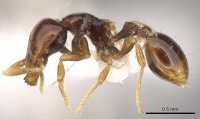Strumigenys raptans
| Strumigenys raptans | |
|---|---|

| |
| Scientific classification | |
| Kingdom: | Animalia |
| Phylum: | Arthropoda |
| Class: | Insecta |
| Order: | Hymenoptera |
| Family: | Formicidae |
| Subfamily: | Myrmicinae |
| Tribe: | Attini |
| Genus: | Strumigenys |
| Species: | S. raptans |
| Binomial name | |
| Strumigenys raptans (Bolton, 2000) | |
Nothing is known about the biology of Strumigenys raptans.
Identification
Bolton (2000) - A member of the Strumigenys appretiata-group. For differentiation of raptans from its closest relatives see notes under Strumigenys glenognatha, Strumigenys halosis and Strumigenys wheeleriana.
Keys including this Species
Distribution
Latitudinal Distribution Pattern
Latitudinal Range: 5.133333333° to -17.19722222°.
| North Temperate |
North Subtropical |
Tropical | South Subtropical |
South Temperate |
- Source: AntMaps
Distribution based on Regional Taxon Lists
Neotropical Region: Colombia (type locality).
Distribution based on AntMaps
Distribution based on AntWeb specimens
Check data from AntWeb
Countries Occupied
| Number of countries occupied by this species based on AntWiki Regional Taxon Lists. In general, fewer countries occupied indicates a narrower range, while more countries indicates a more widespread species. |

|
Estimated Abundance
| Relative abundance based on number of AntMaps records per species (this species within the purple bar). Fewer records (to the left) indicates a less abundant/encountered species while more records (to the right) indicates more abundant/encountered species. |

|
Biology
Castes
Nomenclature
The following information is derived from Barry Bolton's Online Catalogue of the Ants of the World.
- raptans. Pyramica raptans Bolton, 2000: 162 (w.) COLOMBIA. Combination in Strumigenys: Baroni Urbani & De Andrade, 2007: 126
Unless otherwise noted the text for the remainder of this section is reported from the publication that includes the original description.
Description
Worker
Holotype. TL 2.2, HL 0.59, HW 0.54, CI 9 1 , ML 0. 10, MI 17, SL 0.23, SI 43, PW 0.29, AL 0.60. Pronotal humeral hair and pair on mesonotum long and flagellate. Pronotum and mesonotum mostly or entirely smooth. Hairs on first gastral tergite long and fine, flexuous to subflagellate. Ventral surface of petiole peduncle with a small triangular lamellate process, located approximately below the level of the anterior face of the node. Petiole node in dorsal view slightly longer than broad, its dorsum not densely reticulate-punctate. Spongiform appendages of postpetiole moderately developed; in dorsal view width of one of the lateral lobes distinctly greater than one-quarter the width of the disc. Ventral spongiform lobe relatively large, attached along almost the entire length of the sternite and its maximum depth exceeding half the height of the segment. Basigastral costulae short but sharply defined and distinct; first gastral tergite otherwise smooth and unsculptured.
Paratypes. TL 2.0-2.2, HL 0.55-0.58, HW 0.48-0.54, CI 87-93, ML 0.10, MI 17-18, SL 0.20-0.24, SI 42-44, PW 0.26-0.30, AL 0.53-0.60 (2 measured).
Type Material
Holotype worker, Colombia: C'marca, Transecto Sumapaz, i.1983, 1700 m. (T. van der Hammen) (The Natural History Museum). Paratypes. 2 workers with same data as holotype (University of California, Davis).
References
- Baroni Urbani, C. & De Andrade, M.L. 2007. The ant tribe Dacetini: limits and constituent genera, with descriptions of new species. Annali del Museo Civico di Storia Naturale “G. Doria”. 99:1-191.
- Bolton, B. 2000. The ant tribe Dacetini. Memoirs of the American Entomological Institute. 65:1-1028. (page 162, worker described)
References based on Global Ant Biodiversity Informatics
- Bolton, B. 2000. The Ant Tribe Dacetini. Memoirs of the American Entomological Institute 65

